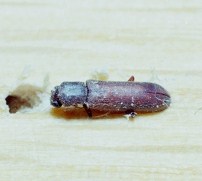
The rove beetles are a family (Staphylinidae) of beetles, primarily distinguished by their short elytra that typically leave more than half of their abdominal segments exposed. With roughly 63,000 species in thousands of genera, the group is currently recognized as the largest extant family of organisms. It is an ancient group, with fossilized rove beetles known from the Triassic, 200 million years ago, and possibly even earlier if the genus Leehermania proves to be a member of this family. They are an ecologically and morphologically diverse group of beetles, and commonly encountered in terrestrial ecosystems.

The Asian long-horned beetle, also known as the starry sky, sky beetle, or ALB, is native to eastern China, and Korea. This species has now been accidentally introduced into the United States, where it was first discovered in 1996, as well as Canada, and several countries in Europe, including Austria, France, Germany, Italy and UK. This beetle is believed to have been spread from Asia in solid wood packaging material.

The longhorn beetles (Cerambycidae), also known as long-horned or longicorns, are a large family of beetles, with over 35,000 species described. Most species are characterized by extremely long antennae, which are often as long as or longer than the beetle's body. In various members of the family, however, the antennae are quite short and such species can be difficult to distinguish from related beetle families such as the Chrysomelidae. The scientific name of this beetle family goes back to a figure from Greek mythology: after an argument with nymphs, the shepherd Cerambus was transformed into a large beetle with horns.

Bookworm is a general name for any insect that is said to bore through books.

Pest control is the regulation or management of a species defined as a pest; any animal, plant or fungus that impacts adversely on human activities or environment. The human response depends on the importance of the damage done and will range from tolerance, through deterrence and management, to attempts to completely eradicate the pest. Pest control measures may be performed as part of an integrated pest management strategy.

A bark beetle is the common name for the subfamily of beetles Scolytinae. Previously, this was considered a distinct family (Scolytidae), but is now understood to be a specialized clade of the "true weevil" family (Curculionidae). Although the term "bark beetle" refers to the fact that many species feed in the inner bark (phloem) layer of trees, the subfamily also has many species with other lifestyles, including some that bore into wood, feed in fruit and seeds, or tunnel into herbaceous plants. Well-known species are members of the type genus Scolytus, namely the European elm bark beetle S. multistriatus and the large elm bark beetle S. scolytus, which like the American elm bark beetle Hylurgopinus rufipes, transmit Dutch elm disease fungi (Ophiostoma). The mountain pine beetle Dendroctonus ponderosae, southern pine beetle Dendroctonus frontalis, and their near relatives are major pests of conifer forests in North America. A similarly aggressive species in Europe is the spruce ips Ips typographus. A tiny bark beetle, the coffee berry borer, Hypothenemus hampei is a major pest on coffee plantations around the world.

Frass refers loosely to the more or less solid excreta of insects, and to certain other related matter.

Powderpost beetles are a group of seventy species of woodboring beetles classified in the insect subfamily Lyctinae. These beetles, along with spider beetles, death watch beetles, common furniture beetles, skin beetles, and others, make up the superfamily Bostrichoidea. While most woodborers have a large prothorax, powderpost beetles do not, making their heads more visible. In addition to this, their antennae have two-jointed clubs. They are considered pests and attack deciduous trees, over time reducing the wood to a powdery dust. The damage caused by longhorn beetles is often confused with that of powderpost beetles, but the two groups are unrelated. The larvae of the Cerambycidae are white, straight and generally flat-headed, whereas those of the Bostrichidae are white and C-shaped.

The common furniture beetle or common house borer is a woodboring beetle originally from Europe but now distributed worldwide. In the larval stage it bores in wood and feeds upon it. Adult Anobium punctatum measure 2.7–4.5 millimetres (0.11–0.18 in) in length. They have brown ellipsoidal bodies with a prothorax resembling a monk's cowl.

The family Oedemeridae is a cosmopolitan group of beetles commonly known as false blister beetles, though some recent authors have coined the name pollen-feeding beetles. There are some 100 genera and 1,500 species in the family, mostly associated with rotting wood as larvae, though adults are quite common on flowers. The family was erected by Pierre André Latreille in 1810.

The Bostrichidae are a family of beetles with more than 700 described species. They are commonly called auger beetles, false powderpost beetles, or horned powderpost beetles. The head of most auger beetles cannot be seen from above, as it is downwardly directed and hidden by the thorax. Exceptions are the powderpost beetles, and members of the subfamily Psoinae.
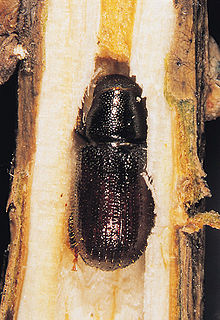
Tomicus piniperda, the common pine shoot beetle, is a bark beetle native throughout Europe, northwestern Africa, and northern Asia. It is one of the most destructive shoot-feeding species in northern Europe.

Lyctus is a genus of powder-post beetles in the family Bostrichidae, being present on all continents except Antarctica.
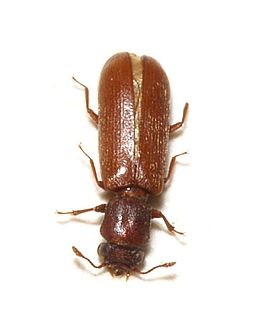
Lyctus brunneus is a xylophage (wood-eating) insect a species of beetle in the family Bostrichidae. It is a member of the subfamily Lyctinae, the powderpost beetles. It is known commonly as the brown powderpost beetle or brown lyctus beetle.
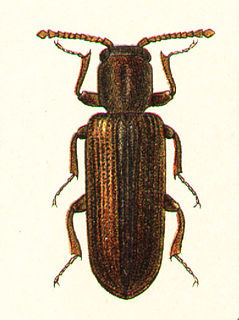
Lyctus suturalis is a species of beetles in the family Bostrichidae, present in the Palearctic and the Near East. In Europe, it is only found in Belarus and Ukraine.

Lyctus carbonarius is a wood-boring beetle in the family Bostrichidae, commonly known as the southern lyctus beetle or lyctid powderpost beetle. It is a serious pest of hardwoods including ash, hickory, oak, maple and mahogany and can infest many products in the home including hardwood flooring and structural timbers, plywood, furniture, tool handles, picture frames, baskets and ladders. Timber can be infested in one location and then be transported large distances by ship, after which the beetles can emerge and spread the infestation to new areas.

Hylastes ater is a species of beetle in the family Curculionidae, the true weevils. It is a bark beetle, a member of the subfamily Scolytinae. Its common name is the black pine bark beetle. It is native to Europe and parts of Asia, including China and Korea. It is known as an introduced species in many other regions, including Australia, New Zealand, the Americas, and South Africa. It is a pest of pines and other trees, and it is widespread in areas where pine trees are cultivated. The species "is an important threat to the biosecurity of all forested countries."
Integrated pest management in museums, libraries, archives and private collections is the practice of monitoring and managing pest and environmental information with pest control methods to prevent pest damage to collections and cultural property. Preserving cultural property is the ultimate goal for these institutions. The pests come in many different forms: insects, mites, rodents, bats, birds, and fungi and the two most common types are insects and fungi. It is widely recommended that every museum have some form of pest control in place and monitoring system to protect their collection and that museums review their storage and museum facilities to determine how to best control and prevent pest infestations while utilizing an Integrated Pest Management plan.
The Forest Products Research Laboratory was a research institute in Buckinghamshire, mainly studying the economic value of tropical forests in the British Empire.
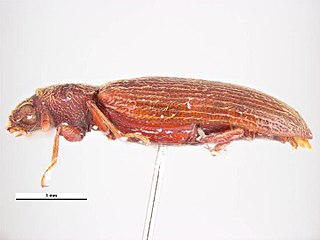
Lyctus cavicollis, known generally as the shiny powderpost beetle or western lyctus beetle, is a species of powder-post beetle in the family Bostrichidae. It is found in Australia, Europe and Northern Asia, and North America.

